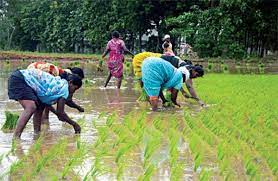- As you are aware, India is an agrarian country despite the astounding improvement on every front that is made possible by discoveries made possible by information technology. It makes sense that the services sector is expanding at the same time that the Union Government’s digitization initiatives are producing outstanding achievements. Despite the Central Government offering productivity-linked incentives to provide the vertical extra boost, the manufacturing sector still lags. Even after the think tank made contemporary techniques available, authorities still have concerns about the farm sector’s ability to support growth. Yet, efforts are being made to wean a sizable portion away from the agriculture sector, which should be pursued properly.

PC: Tooba Maher
- We all know how the agriculture sector is heavily dependent on the monsoon, and any disturbances in the normal forecast of the monsoon owing to environmental degradation are bound to be reflected in the country’s food production. Thus, it’s always a concern for the Union Government and other stakeholders as to what is in store vis-à-vis monsoons. As such, the onset of the southwest monsoon is a keenly tracked event. IMD recently said that rains will hit Kerala this year on June 4, a delay of four days. In the last five years, there have been two occasions when the monsoon’s onset overshot the June 1 mark. Therefore, a delay this year is not a signifier of what lies ahead. But concerns will remain for the policymakers.
- Remember, a delay in the onset and subsequent progress of the monsoon will normally lead to delayed sowing. The southwest monsoon, which contributes about 75% of the annual rainfall, is one of the main influences on agricultural output. Not only does it directly influence kharif crops, but it also has an indirect influence on the winter crop season through its impact on storage levels in reservoirs. Among the aspects of the southwest monsoon that have a critical impact on food security and inflation is the spatial spread of rainfall and its pattern. For instance, July and August are the most crucial months as about 63% of the rainfall is experienced then. Also, the lopsided nature of India’s procurement system for cereals means a disproportionate impact on inflation.

PC: Skymet Weather Team
- Thankfully, April’s retail inflation reading was favorable. CPI was 4.7%, dragged down mainly by the falling food price index. The food price index inflated at just 3.8%. There are concerning aspects to this situation; cereal inflation in April was 13.7%. Given that paddy is India’s most important crop in terms of output, the southwest monsoon is essential due to the country’s high cereal inflation. Because of this, sowing in a lot of India will depend on the monsoon’s development a little later rather than just its delayed arrival. Overall, the southwest monsoon continues to be important, but it’s not the only significant weather-related factor that affects yield. Severe weather conditions, such as the heat wave in March 2022, have had a significant effect on yields and inflation. Let’s be ready for anything that might happen.





